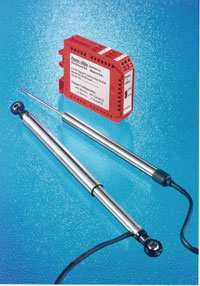
Posted to News on 1st Nov 2013, 00:00
Using linear variable differential transformers
A Linear Variable Differential Transformer (LVDT) is a linear displacement transducer that works on the principle of mutual inductance, producing an electrical signal that is proportional to a separate moving core (or armature). They are avialable in two operation types: differential and ratiometric.

>The latest technology, ratiometrically-driven LVDTs, measure secondary voltages independently to generate a ratio of the difference divided by the sum of these values (Ratio = Va-Vb ÷ Va+Vb). This configuration is commonly referred to as 'ratiometric' operation and will provide higher system accuracy performance than operation in the differential mode.
>The fundamental advantages of LVDT transducers, compared to other types of displacement transducer, are their high degree of robustness, low friction, infinite resolution and ability to operate at high temperatures.
>Compared to differential LVDTs, ratiometric operation provides:
>
- improved immunity to LVDT supply voltage and frequency variations
- improved immunity to errors due to temperature effects on LVDT sensitivity
- improved frequency and phase response
- improved immunity to common-mode noise on LVDT lines
- improved transducer interchange-ability
>The latest developments in LVDT technology include significant reductions in both size and weight with, for example, the diameter of LVDTs reduced from 19mm to 6mm. Where small and lightweight components are required, including aerospace and motorsport applications, such savings are the 'Holy Grail' that engineers constantly seek.
>Penny + Giles' development of ratiometrically-driven LVDTs (replacing standard differentially-driven versions) eliminated the effects of temperature, input variations and noise spikes to provide a sensor that was extremely stable. This converted many, including F1 teams, to the benefits of electronically-driven LVDTs and has established Penny + Giles as the pre-eminent LVDT supplier to the wider motorsport industry.
>Uses and applications for LVDTs are many and varied. For motorsport applications for example, because of the temperatures involved (in excess of 1000°C for F1 applications) LVDTs are used for brake positioning and pad wear sensing. In the rail industry, a recent application for diesel-electric locomotives used LVDT technology to bridge the gap between the old electro-hydraulic and new electronic control and power equipment, whose designs were conceived many decades apart. The new systems provide faster feedback signals, allowing the locomotive's new electronic control system to respond to power changes much more quickly than the existing hydraulically controlled system.
>Penny + Giles' high-performance ratiometric LVDT's can be supplied in a range of shaft and body configurations to suit multiple applications.
>Their design benefits from the extensive experience the company has gained in fly-by-wire control systems for flight-critical aerospace/military applications; using high-integrity coil, screen and connection assemblies, combined with welded and vacuum brazed stainless steel construction.
>The LVDT's contactless operating principle allows a fit-and-forget installation so that zero maintenance programmes can be incorporated.









